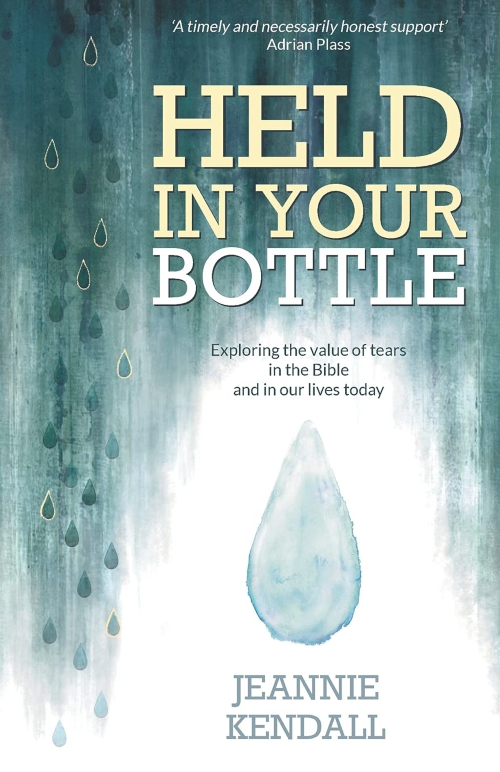
At peace with my tears through writing
The written word has long been one of the primary ways Baptist minister Jeannie Kendall has made sense of the world. Her second book, conceived before but written during the pandemic, explores the varied occasions in the Bible when men and women shed tears. She hopes God can use her words to bring understanding to others.
When I was 13, following a short story I had written, my English teacher offered me a year with no homework to write a novel. A more street-wise child might have taken him up on the offer and found an excuse at the end of the year, but instead I said that I did not have anything to say. I often wish he had lived long enough for me to send him a copy of my first book.
He had recognised that, as actually quite a troubled teenager, words were one of the primary ways I made sense of the world or, where this was not possible, poured out my questions, difficulties and pain - and at times my anger.
I have always written. The genre has varied at times, while always including poetry. Curiously, I struggle with journaling, which so many find helpful. There is something too raw, and perhaps too permanent, for me in expressing my own feelings in too direct a form. They vacillate so from day to day. What I do find helpful, and I suspect at times fulfils a cathartic function, is to explore biblical characters imaginatively – my own variation of Ignatian prayer. These explorations formed the basis of my first book,
Finding Our Voicei, and the retelling of some pretty gritty themes, including depression, forgiveness and and abuse, through those biblical characters made it possible for some people to tell their own stories, some for the first time.

My second book,
Held in Your Bottle, was conceived in the autumn of 2019. I had seen some photographs of tears cried in diverse circumstances and put under a microscope
ii. The results were beautiful, and surprisingly different from each other. I began to wonder if there was a book that might emerge from an exploration of varied occasions in the Bible when both men and women shed tears. Having spent years as a counsellor and then a minister, it had been my privilege to sit with many people weeping. So often they would apologise, as though tears were a source of shame rather than release. I also recognised my own ambivalence to my tears and that the book would need me to be honest and make myself vulnerable. I scoped out the book and the publishers gave me the go-ahead.
And then the pandemic hit.
The first lockdown was declared, and I could not see my children or grandchildren. I left baking on the doorstep for our grandchildren who lived in the same road, but the bewilderment, particularly in the eyes of the youngest one, who could not understand why Nana and Grandy were standing at a distance not hugging him, was almost unbearable.
I could not cry. The emotions were simply too many and too intense. I was still a minister at the time
iii, and several church members became very unwell with it. Someone I knew died. There were several others who died from other causes, where I was privileged to conduct or share in their funerals, but the marking of their lives was diminished compared to what it would have been in different times. I could not visit a friend who was dying, able only to send him voice messages to be held to his ear. Such experiences were being replicated everywhere and at times I felt completely overwhelmed by the scale of suffering.
Somehow, amid all this, the second book emerged, and I hope was stronger for having been written in those circumstances. It has a simple structure – each chapter having a current story of tears cried, a biblical story with the same kind of weeping, some accessible psychological insight drawn from my training and experience on the emotion being expressed, and some questions for reflection which can be used individually or in a small group setting.
It covers eleven kinds of tears, as well as chapters on unshed tears, our tears being seen by God, tears and prayer, and the ultimate ending of tears. I think the emphasis on stories means it is not only suitable for Christians. So many of us, whether we have faith or not, struggle to understand and express our emotions.
The book is not my personal therapy, though I have been honest about some of my life experiences. Yet I think, on reflection, that writing it amid my own personal wrestling with the horror of the pandemic, has perhaps given it an even greater underlying authenticity.
I have still not cried. No doubt I will, in time. Last week though, someone who had read the book said she had been able to cry about some difficult things she had buried, and my hope is that will be the experience of many others; that God, in his grace, can use my words to bring understanding and perhaps healing to those who read it.
Click here to
download a pdf version of this article
i Published in July 2019, Authentic Media Rose-Lynn Fisher
ii The Topography of Tears Bellevue Literary Press 2017
iii I am now ‘freelance’, aka retired from full-time local church ministry, though still active in ministry in a number of ways
Illustration by Vivian Hansen